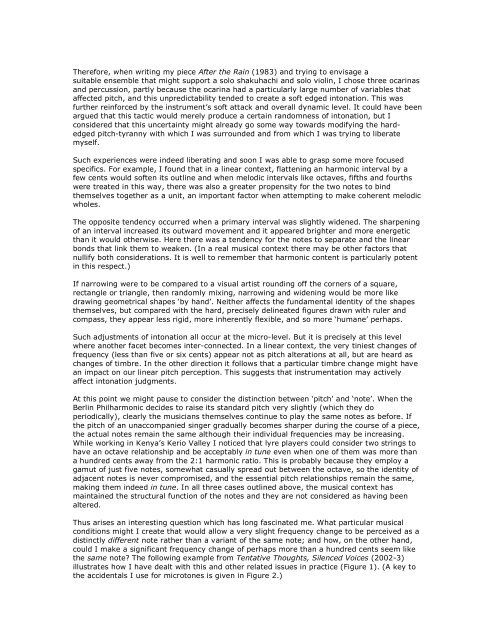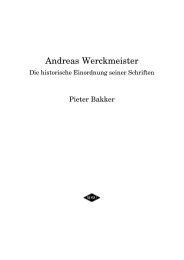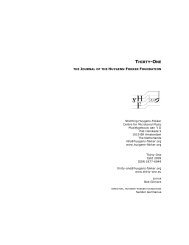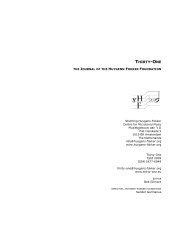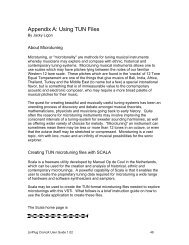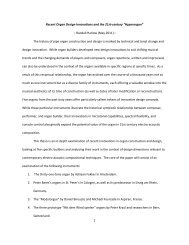Some Thoughts on Linear Microtonality - Frank Denyer - Stichting ...
Some Thoughts on Linear Microtonality - Frank Denyer - Stichting ...
Some Thoughts on Linear Microtonality - Frank Denyer - Stichting ...
Create successful ePaper yourself
Turn your PDF publications into a flip-book with our unique Google optimized e-Paper software.
Therefore, when writing my piece After the Rain (1983) and trying to envisage asuitable ensemble that might support a solo shakuhachi and solo violin, I chose three ocarinasand percussi<strong>on</strong>, partly because the ocarina had a particularly large number of variables thataffected pitch, and this unpredictability tended to create a soft edged int<strong>on</strong>ati<strong>on</strong>. This wasfurther reinforced by the instrument’s soft attack and overall dynamic level. It could have beenargued that this tactic would merely produce a certain randomness of int<strong>on</strong>ati<strong>on</strong>, but Ic<strong>on</strong>sidered that this uncertainty might already go some way towards modifying the hardedgedpitch-tyranny with which I was surrounded and from which I was trying to liberatemyself.Such experiences were indeed liberating and so<strong>on</strong> I was able to grasp some more focusedspecifics. For example, I found that in a linear c<strong>on</strong>text, flattening an harm<strong>on</strong>ic interval by afew cents would soften its outline and when melodic intervals like octaves, fifths and fourthswere treated in this way, there was also a greater propensity for the two notes to bindthemselves together as a unit, an important factor when attempting to make coherent melodicwholes.The opposite tendency occurred when a primary interval was slightly widened. The sharpeningof an interval increased its outward movement and it appeared brighter and more energeticthan it would otherwise. Here there was a tendency for the notes to separate and the linearb<strong>on</strong>ds that link them to weaken. (In a real musical c<strong>on</strong>text there may be other factors thatnullify both c<strong>on</strong>siderati<strong>on</strong>s. It is well to remember that harm<strong>on</strong>ic c<strong>on</strong>tent is particularly potentin this respect.)If narrowing were to be compared to a visual artist rounding off the corners of a square,rectangle or triangle, then randomly mixing, narrowing and widening would be more likedrawing geometrical shapes ‘by hand’. Neither affects the fundamental identity of the shapesthemselves, but compared with the hard, precisely delineated figures drawn with ruler andcompass, they appear less rigid, more inherently flexible, and so more ‘humane’ perhaps.Such adjustments of int<strong>on</strong>ati<strong>on</strong> all occur at the micro-level. But it is precisely at this levelwhere another facet becomes inter-c<strong>on</strong>nected. In a linear c<strong>on</strong>text, the very tiniest changes offrequency (less than five or six cents) appear not as pitch alterati<strong>on</strong>s at all, but are heard aschanges of timbre. In the other directi<strong>on</strong> it follows that a particular timbre change might havean impact <strong>on</strong> our linear pitch percepti<strong>on</strong>. This suggests that instrumentati<strong>on</strong> may activelyaffect int<strong>on</strong>ati<strong>on</strong> judgments.At this point we might pause to c<strong>on</strong>sider the distincti<strong>on</strong> between ‘pitch’ and ‘note’. When theBerlin Philharm<strong>on</strong>ic decides to raise its standard pitch very slightly (which they doperiodically), clearly the musicians themselves c<strong>on</strong>tinue to play the same notes as before. Ifthe pitch of an unaccompanied singer gradually becomes sharper during the course of a piece,the actual notes remain the same although their individual frequencies may be increasing.While working in Kenya’s Kerio Valley I noticed that lyre players could c<strong>on</strong>sider two strings tohave an octave relati<strong>on</strong>ship and be acceptably in tune even when <strong>on</strong>e of them was more thana hundred cents away from the 2:1 harm<strong>on</strong>ic ratio. This is probably because they employ agamut of just five notes, somewhat casually spread out between the octave, so the identity ofadjacent notes is never compromised, and the essential pitch relati<strong>on</strong>ships remain the same,making them indeed in tune. In all three cases outlined above, the musical c<strong>on</strong>text hasmaintained the structural functi<strong>on</strong> of the notes and they are not c<strong>on</strong>sidered as having beenaltered.Thus arises an interesting questi<strong>on</strong> which has l<strong>on</strong>g fascinated me. What particular musicalc<strong>on</strong>diti<strong>on</strong>s might I create that would allow a very slight frequency change to be perceived as adistinctly different note rather than a variant of the same note; and how, <strong>on</strong> the other hand,could I make a significant frequency change of perhaps more than a hundred cents seem likethe same note? The following example from Tentative <str<strong>on</strong>g>Thoughts</str<strong>on</strong>g>, Silenced Voices (2002-3)illustrates how I have dealt with this and other related issues in practice (Figure 1). (A key tothe accidentals I use for microt<strong>on</strong>es is given in Figure 2.)


